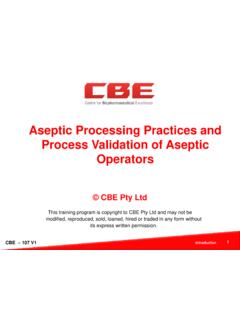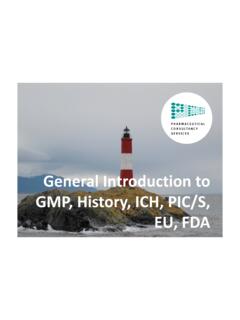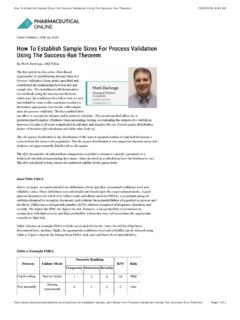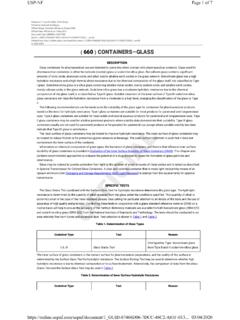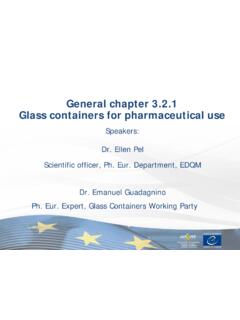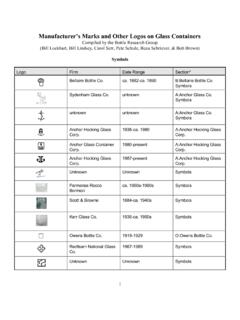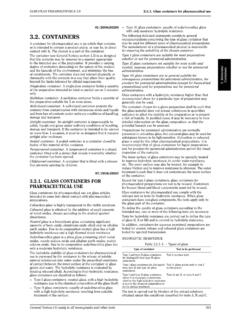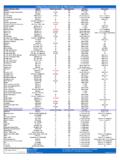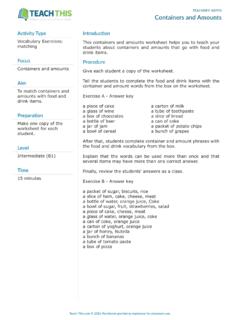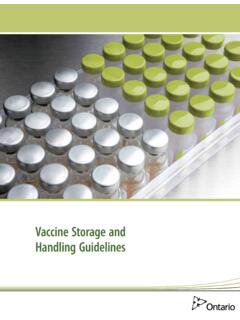Transcription of Type I Glass for Pharmaceutical Containers: Technical ...
1 Type I Glass for Pharmaceutical Containers: Technical Requirements and regulatory updateDaniele Zuccato, Core Team Leader-Strictly ConfidentialTopicsGlass Containers for PharmaceuticalUseGlass Containers ProductionDelaminationRegulatoryUpdatesT his is the title of the Section of the current editionof the European Pharmacopoeia, EPF. Nicoletti -2014 Glass Containers for Pharmaceutical Use4-Strictly ConfidentialGlass Containers for Pharmaceutical UseGlassesAccordingto the EuropeanPharmacopoeia(EP)Titrationof the ExtractSolution obtainedfrom10 g glasspowderin 50 ml water at121 C for 30 GlassIdentificationItem( Glass GrainTest)NeutralGlassLimit Value 0,10mlHCl0,02 MPer gramof glassSoda Lime SilicaGlassLimit Value 0,85mlHCl0,02 MPer gramof glass5-Strictly ConfidentialTypeIHigh HRTypeIIHigh HRTypeIIIM oderateHRGlass Containers for Pharmaceutical UseGlass Containers According to the European Pharmacopoeia (EP)6-Strictly ConfidentialGlass Containers for Pharmaceutical UseGlass Containers.
2 TypeI Accordingto the EuropeanPharmacopoeia(EP)Definition Neutral Glass , with a high hydrolytic resistance due to the chemical composition of the Glass itself .RecommendationFor Use Suitable for most preparations whether or not for parenteral use .TypeIHigh HR7-Strictly ConfidentialDefinition Usually of soda-lime-silica Glass with a high hydrolytic resistance resulting from suitable treatment of the surface .RecommendationFor Use Suitable for most acidic and neutral, aqueous preparations whether or not for parenteral use .TypeIIHigh HRGlass Containers for Pharmaceutical UseGlass Containers: Type II According to the European Pharmacopoeia (EP)8-Strictly ConfidentialDefinition Usually of soda-lime-silica Glass with only moderate hydrolytic resistance.
3 RecommendationFor Use In general suitable for non-aqueous preparations for parenteral use, for powders for parenteral use (except for freeze-dried preparations) and for preparations not for parenteral use .TypeIIIM oderate HRGlass Containers for Pharmaceutical UseGlass Containers: Type III According to the European Pharmacopoeia (EP)9-Strictly ConfidentialFillingVolume (mL)TypesI and IITypesIII 12,020,01 21,817,62 31,616,13 5 1,313,25 101,010,210 200,808,120 500,606,150 1000,504,8 Maximum volume of HCl0,01 M for 100 ml of extract solution after 1 h at 121 CGlass Containers According to the European Pharmacopoeia (EP)10-Strictly Confidential DistinctionbetweenTypeI and II glasscontainersEtchingTestArsenicTestSpe ctralTransmission Appliedto glasscontainers for aqueousparenteralpreparations.
4 Limit Value 0,1 ppmof As For coloured glasscontainers UV-VIS sprectrometerwith an integratingsphereGlass Containers for Pharmaceutical UseGlass Containers According to the European Pharmacopoeia (EP)11-Strictly ConfidentialFillingVolume (ml)TypesIand II 15,001 24,502 34,103 5 3,205 102,5010 202,0020 501,5050 1001,20 Limit Valuesfor the concentrationsof oxides, expressedassodiumoxidemg/mlGlass Containers for Pharmaceutical UseGlass Containers According to the Annex to the European Pharmacopoeia (EP)12-Strictly ConfidentialNo Containers Surface Test according to EPTitration test of the aqueous extract solution after 1 hour at 121 CThe test is compulsoryIndividual alkali release by FAAS according to the EP AnnexThe test is suggested as an additional tool for production quality controlGlass Containers for Pharmaceutical UseGlass Containers According to the Attachment to the European Pharmacopoeia (EP)
5 -Strictly ConfidentialTopicsGlass Containers for PharmaceuticalUseGlass Containers ProductionDelaminationRegulatoryUpdates1 4-Strictly Confidential The container chosen for a given preparation shall be such that the Glass material does not release substances in quantities sufficient to affect the stability of the preparation or to present a risk of toxicity. Glass Containers for Pharmaceutical UseThe Principle of the EP15-Strictly ConfidentialOxidesWeight%SiO 73,0B O 11,0Al O 6,0Na O+ K O8,0 CaO+ BaO2,0 Glass Containers for Pharmaceutical UseChemical Composition of Type I Glasses16-Strictly ConfidentialGlass Containers for Pharmaceutical UseHydrolytic ResistanceAcidiccontributionAlkalinecont ributionAmphotericcontribution++SiO > Na O+K O> B O > CaO+BaO> Al O 17-Strictly ConfidentialGlass Containers for Pharmaceutical UseGlass Tubing ProductionDanneror VelloprocessfromMolten GlassIntoGlass Tubing FromGlass Tubing intothe final Glass container Glass Convertingprocess1218-Strictly ConfidentialGlass Containers for Pharmaceutical UseProduction of Glass Tubing Containers19-Strictly ConfidentialGlass Containers for Pharmaceutical UseProduction of Glass Tubing Containers20-Strictly ConfidentialLef t t
6 UrretCent ral t urretRight t urretGlass Containers for PharmaceuticalUseProduction of Glass TubingContainers21-Strictly ConfidentialGlass Containers for Pharmaceutical UseProduction of Glass Tubing Containers22-Strictly ConfidentialFlameDrillingGlass Containers for Pharmaceutical UseProduction of Glass Tubing Containers23-Strictly ConfidentialGlass Containers for Pharmaceutical UseProduction of Glass Tubing ContainersBottomForming24-Strictly Confidentialtemperaturetimestabilization annealingpointstrainpointGlass Containers for Pharmaceutical UseProduction of Glass Tubing Containers25-Strictly ConfidentialGlass Containers for Pharmaceutical UseProduction of Glass Tubing ContainersGlass container Internal SurfaceTubingSize(Dimensionaltolerances) State of InternalSurfaceof TubingFormingStages(Temperaturesand times)Annealing(Temperaturesand times)26-Strictly ConfidentialGlass Containers for Pharmaceutical UseProduction of Glass Tubing ContainersOD: 20,00 0,20 mmWT: 1,00 0,04 mmWT MAX: mmOD MAX: mmWT min: mmOD min: 19,80 mm m=-27-Strictly Confidential m= 4 % (generally 2%) m=massQ= Kaloriesm= glassmassC= glassspecificheatT= temperatureGlass Containers for Pharmaceutical UseProduction of Glass Tubing ContainersQ = m c T28-Strictly ConfidentialGlass Tubing Internal Surface StateRoughness:Increaseof the surfaceareaSize of the elemental structure units.
7 Higher cooling rates generate larger structural units with lower chemical resistanceGlass Containers for Pharmaceutical UseProduction of Glass Tubing Containers29-Strictly ConfidentialForming Temperatures and TimesThe migration of elements from bulk to the surface increases with increasing temperature and timePhase separation and sublimation of alkali boratesGlass Containers for Pharmaceutical UseProduction of Glass Tubing Containers30-Strictly ConfidentialAnnealingAlkali surfacing effect due to the increased thermal mobility of ions as a function of temperature and alkali extractabilityGlass Containers for Pharmaceutical UseProduction of Glass Tubing Containers31-Strictly Confidential Sulphurtreatment; Siliconisation; Ion Exchange; PECVD.
8 OthersGlass Containers for Pharmaceutical UseProduction of Glass Tubing Containers32-Strictly ConfidentialSulfur TreatmentAt high temperature ammonium sulphatedecomposes and reacts with surface alkaliesforming water soluble diffused opalescence gives visual evidence of the washing, a silica enriched layer is formed which acts as a barrier to further alkali Containers for Pharmaceutical UseProduction of Glass Tubing Containers33-Strictly ConfidentialGlass Containers for Pharmaceutical UseProduction of Glass Tubing ContainersSulfur Treatment34-Strictly ConfidentialSiliconizationIs usually made to favor the complete extraction of the drug from the container and the plungergliding in coating contributes to reduce the alkali extraction from glassGlass Containers for Pharmaceutical UseProduction of Glass Tubing Containers35-Strictly ConfidentialGlass Containers for PharmaceuticalUseProduction of Glass TubingContainersSiliconization Direct connection to the forming line
9 Servomotor movements with adjustable speed for nozzles Volumetric pumps for silicone emulsion Multiple injection Air flow control for spraying system Suction system to prevent external contamination36-Strictly ConfidentialChemical StrenghteningIs obtained by a particular process that helps the substitution of Na+ ions present on the Glass surface with K+ ionsThis exchange put in compression the Glass surface so increasing the overall mechanical resistance of the containerGlass Containers for Pharmaceutical UseProduction of Glass Tubing Containers37-Strictly ConfidentialIonExchangeMechanicalResista nceIncreaseGlass Containers for PharmaceuticalUseProduction of Glass TubingContainers38-Strictly ConfidentialMechanicallystrongerBetterfo r large vials(>100 ml) BetterWallsand Finishdimensionalconsistency Cosmeticallysuperior No Seams Facilitatesinspection Weighsless Easierto label Lower toolingcosts Betterfor LyophilizationMoldedTubularPRO sPRO sGlass Containers for PharmaceuticalUseGlass TubingContainers vs Moldedcontainers-Strictly ConfidentialTopicsGlass Containers for PharmaceuticalUseGlass Containers ProductionDelaminationRegulatoryUpdates4 0-Strictly ConfidentialGlass Containers for Pharmaceutical UseDelamination Separationof thin Glass layers (lamellae)
10 That appear as shiny, needle shaped particles floating in the contact liquid The formation of a silica-rich layer poorly bonded to the substrate is the first stage of an extended delamination Glass -liquid interactions are responsible for the formation of an altered layer41-Strictly ConfidentialGlass Containers for PharmaceuticalUseDelamination Glass liquidinteractionsGlassWFI or Acid LeachingH+Ca++K+ Na+Formation of a alkali depleted layerIncreasing of the layer thicknessCrackingDetachmentof scales42-Strictly ConfidentialGlass Containers for Pharmaceutical UseDelamination of Pharmaceutical Glass The first stage is always the formation of an altered layer When vials are filled with the liquid preparation.




